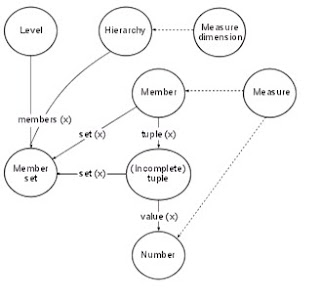Dimensional Coercion Rules - Cognos 8
To simplify building expressions, Cognos 8 provides coercion rules that automatically convert dimensional types. With coercion rules, you can build simpler expressions, making them easier to understand. In addition to the implicit rules that Cognos 8 provides, you can specify these rules explicitly by using various functions.
Cognos 8 supports the following types of coercion:
Coercion rules are applied to expressions and data items. In expressions, an operator or function may require operands to be of a particular dimensional type. When an operand is not of the required type, one or more coercion rules may be applied to coerce the operand to the appropriate type. Coercion rules may also be applied to data items to coerce the data item to a collection of members or values.
Function Operands
The following describes how coercion rules are applied to function operands:
Comparison and Other Symmetric Operators
Binary operators that accept operands of more than one type, such as equals (=) and in, need both operands to be the same dimensional type.
No coercion is possible between value domains (numeric, date, time, and string) or between members and values. Consequently, if either operand is a value type, both must be in the same value domain. Otherwise, the query fails.
Members and member set operands are valid only with the operators equals (=), not equals (<>), in, and not in, where the right side of the expression is a member, member set, or prompt. Only the following are valid:
Exceptions
For the left operand, member sets are supported in detail and summary filter expressions, but not in expressions that use the filter function. Members are not supported in detail and summary filters, but they may be used in expressions that use the filter function.
The in_range operator is not supported for members and member sets.
Normal coercion rules apply to these operands.
NULL operands are considered values, rather than members.
Examples
The following examples illustrate how coercion is applied to levels in expressions with operators.
[Sales].[Products].[].[Product Line] = [Sales].[Products].[].[Product Line]->[Outdoor Equipment]
The left operand is coerced to the following member set:
members( [Sales].[Products].[].[Product Line])
The following expressions are invalid:
The following examples illustrate how coercion is applied to members in expressions with operators. In each of the examples below, the left operand is coerced to a value of the current cell at this member:
(tuple([Sales].[Products].[].[Product Line]->[Outdoor Equipment]))
The following table describes coercion rules that are applied when coercing an object of one dimensional type into another.
Note: Measures and Member Unique Names (MUNs) are considered members.
Source type | Target type | Result |
Measure dimension | Hierarchy | A measure dimension can be used without any conversion as a hierarchy. |
Measure dimension | Member set | The member set contains the members of the measure dimension. This coercion is done in two steps. First, measure dimensions are coerced to hierarchies, and then hierarchies are coerced to member sets. |
Hierarchy | Member set | A set containing the members of the hierarchy. |
Level | Member set | A set containing the members of the level. The equivalent expression is members(level). |
Measure | Member | A measure can be used without any conversion as a member. |
Measure | Tuple | This coercion is done in two steps. First, measures are coerced to members, and then members are coerced to tuples. |
Measure | Member set | This coercion is done in two steps. First, measures are coerced to members, and then members are coerced to member sets. |
Member | Tuple | The tuple consists of the member. The equivalent expression is tuple(member) |
Member | Member set | The set consists of the member. This coercion is done in two steps. First, members are coerced to tuples, and then tuples are coerced to member sets. |
The following table describes the coercion rules for expressions or prompts that return a numeric or string value. These rules apply to functions and operators that require an operand of a particular data type, as well as to binary operators that require operands of the same type.
Source type | Target type | Result |
Measure | Number, Date/Time, or String | The result is the value of the measure at the current cube intersection. |
Member | Number | The result is the value of the cell at the cube intersection specified by the member. This coercion is done in two steps. First, members are coerced to tuples, and then tuples are coerced to the target type. |
Tuple | Number | The value of the cell at the cube intersection specified by the tuple. The equivalent expression is value(operand or parameter) |
The following diagram shows how coercion rules are connected. The expression that coerces a source node type to a target node type is built by following the path that connects them. A dotted line indicates a coercion that does not require an explicit conversion function. This occurs whenever the source type is a specialization of the target type. For example, every measure is a member so you can use measures without conversion wherever a member is required.


Comments
Post a Comment